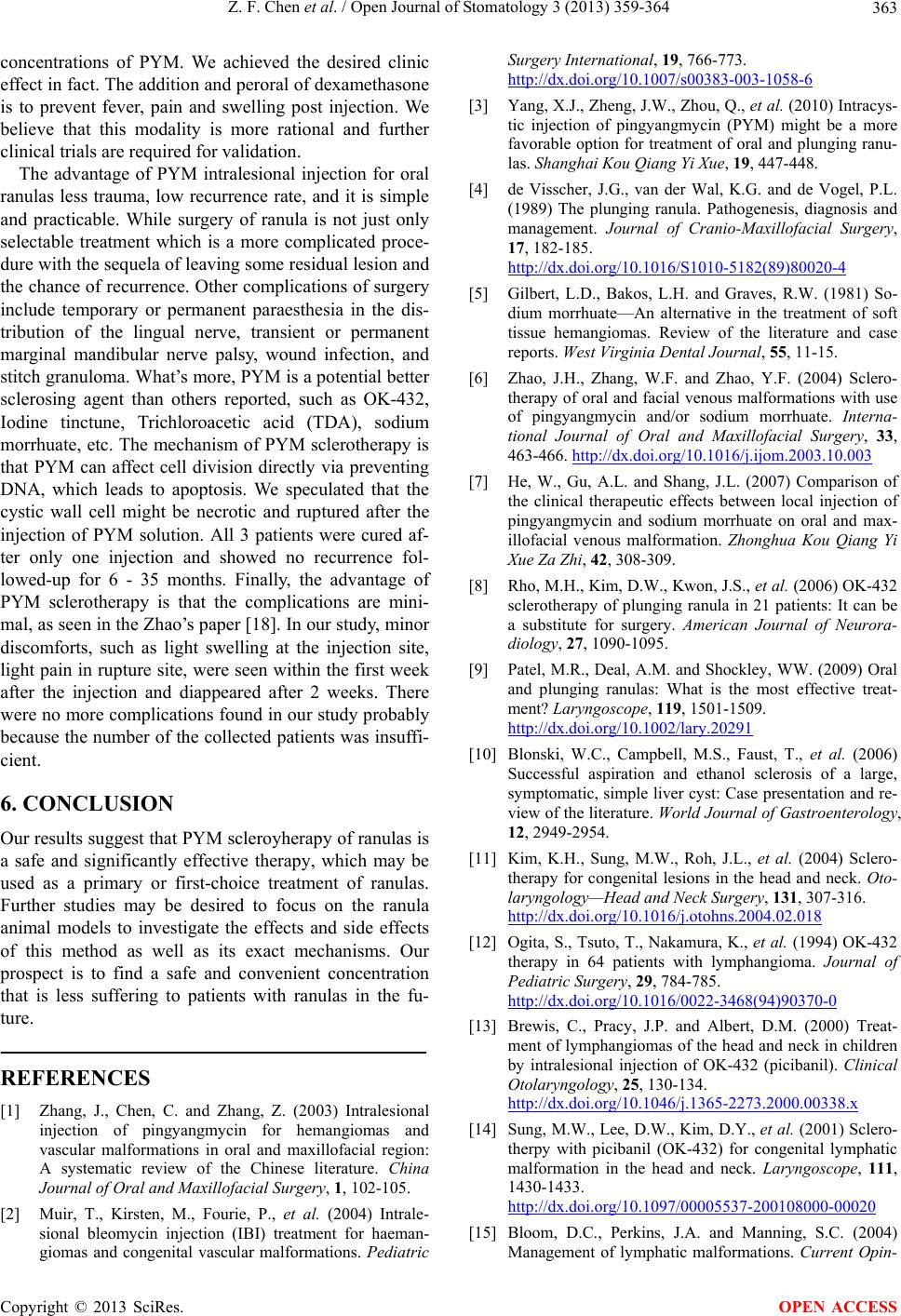
Z. F. Chen et al. / Open Journal of Stomatology 3 (2013) 359-364 363
concentrations of PYM. We achieved the desired clinic
effect in fact. The addition and peroral of dexamethasone
is to prevent fever, pain and swelling post injection. We
believe that this modality is more rational and further
clinical trials are required for validation.
The advantage of PYM intralesional injection for oral
ranulas less trauma, low recurrence rate, and it is simple
and practicable. While surgery of ranula is not just only
selectable treatment which is a more complicated proce-
dure with the sequela of leaving some residual lesion and
the chance of recurrence. Other complications of surgery
include temporary or permanent paraesthesia in the dis-
tribution of the lingual nerve, transient or permanent
marginal mandibular nerve palsy, wound infection, and
stitch granuloma. Wh at’s more, PYM is a potential better
sclerosing agent than others reported, such as OK-432,
Iodine tinctune, Trichloroacetic acid (TDA), sodium
morrhuate, etc. The mechanism of PYM sclerotherapy is
that PYM can affect cell division directly via preventing
DNA, which leads to apoptosis. We speculated that the
cystic wall cell might be necrotic and ruptured after the
injection of PYM solution. All 3 patients were cured af-
ter only one injection and showed no recurrence fol-
lowed-up for 6 - 35 months. Finally, the advantage of
PYM sclerotherapy is that the complications are mini-
mal, as seen in the Zhao’s paper [18]. In our study, minor
discomforts, such as light swelling at the injection site,
light pain in rupture site, were seen within the first week
after the injection and diappeared after 2 weeks. There
were no more complications found in our study probably
because the number of the collected patients was insuffi-
cient.
6. CONCLUSION
Our results suggest that PYM scleroyherap y of ranulas is
a safe and significantly effective therapy, which may be
used as a primary or first-choice treatment of ranulas.
Further studies may be desired to focus on the ranula
animal models to investigate the effects and side effects
of this method as well as its exact mechanisms. Our
prospect is to find a safe and convenient concentration
that is less suffering to patients with ranulas in the fu-
ture.
REFERENCES
[1] Zhang, J., Chen, C. and Zhang, Z. (2003) Intralesional
injection of pingyangmycin for hemangiomas and
vascular malformations in oral and maxillofacial region:
A systematic review of the Chinese literature. China
Journal of Oral and Maxillofacial Surgery, 1, 102-105.
[2] Muir, T., Kirsten, M., Fourie, P., et al. (2004) Intrale-
sional bleomycin injection (IBI) treatment for haeman-
giomas and congenital vascular malformations. Pediatric
Surgery International, 19, 766-773.
http://dx.doi.org/10.1007/s00383-003-1058-6
[3] Yang, X.J., Zheng, J.W., Zhou, Q., et al. (2010) Intracys-
tic injection of pingyangmycin (PYM) might be a more
favorable option for treatment of oral and plunging ranu-
las. Shanghai Kou Qiang Yi Xue, 19, 447-448.
[4] de Visscher, J.G., van der Wal, K.G. and de Vogel, P.L.
(1989) The plunging ranula. Pathogenesis, diagnosis and
management. Journal of Cranio-Maxillofacial Surgery,
17, 182-185.
http://dx.doi.org/10.1016/S1010-5182(89)80020-4
[5] Gilbert, L.D., Bakos, L.H. and Graves, R.W. (1981) So-
dium morrhuate—An alternative in the treatment of soft
tissue hemangiomas. Review of the literature and case
reports. West Virginia Dental Journal, 55, 11-15.
[6] Zhao, J.H., Zhang, W.F. and Zhao, Y.F. (2004) Sclero-
therapy of oral and facial venous malformations with use
of pingyangmycin and/or sodium morrhuate. Interna-
tional Journal of Oral and Maxillofacial Surgery, 33,
463-466. http://dx.doi.org/10.1016/j.ijom.2003.10.003
[7] He, W., Gu, A.L. and Shang, J.L. (2007) Comparison of
the clinical therapeutic effects between local injection of
pingyangmycin and sodium morrhuate on oral and max-
illofacial venous malformation. Zhonghua Kou Qiang Yi
Xue Za Zhi, 42, 308-309.
[8] Rho, M.H., Kim, D.W., Kwon, J.S., et al. (2006) OK-432
sclerotherapy of plunging ranula in 21 patients: It can be
a substitute for surgery. American Journal of Neurora-
diology, 27, 1090-1095.
[9] Patel, M.R., Deal, A.M. and Shockley, WW. (2009) Oral
and plunging ranulas: What is the most effective treat-
ment? Laryngoscope, 119, 1501-1509.
http://dx.doi.org/10.1002/lary.20291
[10] Blonski, W.C., Campbell, M.S., Faust, T., et al. (2006)
Successful aspiration and ethanol sclerosis of a large,
symptomatic, simple liver cyst: Case presentation and re-
view of the literature. World Journal of Gastroenterology,
12, 2949-2954.
[11] Kim, K.H., Sung, M.W., Roh, J.L., et al. (2004) Sclero-
therapy for congenital lesions in the head and neck. Oto-
laryngology—Head and Neck Surgery, 131, 307-316.
http://dx.doi.org/10.1016/j.otohns.2004.02.018
[12] Ogita, S., Tsuto, T., Nakamura, K., et al. (1994) OK-432
therapy in 64 patients with lymphangioma. Journal of
Pediatric Surgery, 29, 784-785.
http://dx.doi.org/10.1016/0022-3468(94)90370-0
[13] Brewis, C., Pracy, J.P. and Albert, D.M. (2000) Treat-
ment of lymphangiomas of the head and neck in children
by intralesional injection of OK-432 (picibanil). Clinical
Otolaryngology, 25, 130-134.
http://dx.doi.org/10.1046/j.1365-2273.2000.00338.x
[14] Sung, M.W., Lee, D.W., Kim, D.Y., et al. (2001) Sclero-
therpy with picibanil (OK-432) for congenital lymphatic
malformation in the head and neck. Laryngoscope, 111,
1430-1433.
http://dx.doi.org/10.1097/00005537-200108000-00020
[15] Bloom, D.C., Perkins, J.A. and Manning, S.C. (2004)
Management of lymphatic malformations. Current Opin-
Copyright © 2013 SciRes. OPEN ACCESS